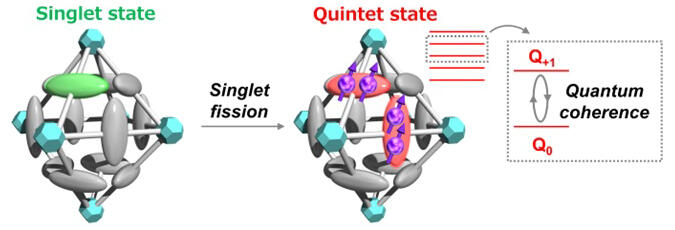A research group led by Graduate Student Akio Yamauchi and Graduate Student Kentaro Tanaka (at the time of research), Associate Professor Nobuhiro Yanai of the Graduate School of Engineering at Kyushu University, Associate Professor Kiyoshi Miyata of the Graduate School of Science at the same university, and the Molecular Photoscience Research Center at Kobe University announced the first successful observation of quantum coherence in the quintet state at room temperature. They have also revealed that by densely integrating dyes in a metal-organic framework (MOF), the quintet state can be generated, and its quantum coherence can be maintained for more than 100 ns at room temperature. This achievement is expected to lead to the realization of ultra-sensitive quantum sensing. The results were published in Science Advances, an international academic journal of the American Association for the Advancement of Science.

Provided by Kyushu University
The most fundamental building block of quantum technologies, such as quantum computing and quantum sensing, is the qubit. Molecular qubits, which utilize the electron spins of molecules, have the advantage of precisely controlling their chemical structure.
Excited states generated by light irradiation of organic dye molecules include an excited singlet state, in which the two electron spins have opposite directions and cancel each other out, and an excited triplet state, in which they do not cancel each other out.
Singlet fission is a phenomenon in which two excited triplet states are produced from an excited singlet state of a molecule, and a special spin state called the quintet state is produced during this process. The quintet state has four electron spins that are spin-polarized (a state where the spins are predominantly occupied in one of the split energy levels, i.e., a state where the spins are aligned). Consequently, it is anticipated to have a higher potential as a 4-qubit system compared to conventional qubits using a single electron spin.
In this study, the quantum coherence in the quintet state produced by singlet fission was successfully observed for the first time at room temperature. A derivative of pentacene, a representative dye that induces singlet fission, was densely introduced, as ligands, into a nanoporous material with a rigid structure called MOF to minimize the movement of the dye. Furthermore, through pulsed electron spin resonance (ESR) measurements (a technique that involves irradiating microwaves onto electrons whose spins are split in energy depending on their orientation in a magnetic field to obtain information about electron spins), quantum coherence in the quintet state was observed at room temperature for the first time.
The measurement results were reproduced through quantum simulations that also considered molecular orientation changes in the spin motion. Consequently, it was demonstrated that the mobility of the dye site is suppressed, and the small changes in the orientation of dyes contribute to the generation of the quintet state and the preservation of quantum coherence in the skeletal lattice vibrations of the MOF.
These findings reveal the important material design considerations for harnessing quantum coherence in the quintet state.
Yanai stated, "In the future, we aim to achieve highly sensitive and selective chemical quantum sensing through the integration of diverse molecular qubits and porous metal complexes. By utilizing the benefits of molecular materials, which offer precise structural control and the ability to introduce porosity, we expect to discover new opportunities for the field of materials chemistry in the era of quantum advancements."
Journal Information
Publication: Science Advances
Title: Room-temperature quantum coherence of entangled multiexcitons in a metal-organic framework
DOI: 10.1126/sciadv.adi3147
This article has been translated by JST with permission from The Science News Ltd. (https://sci-news.co.jp/). Unauthorized reproduction of the article and photographs is prohibited.




